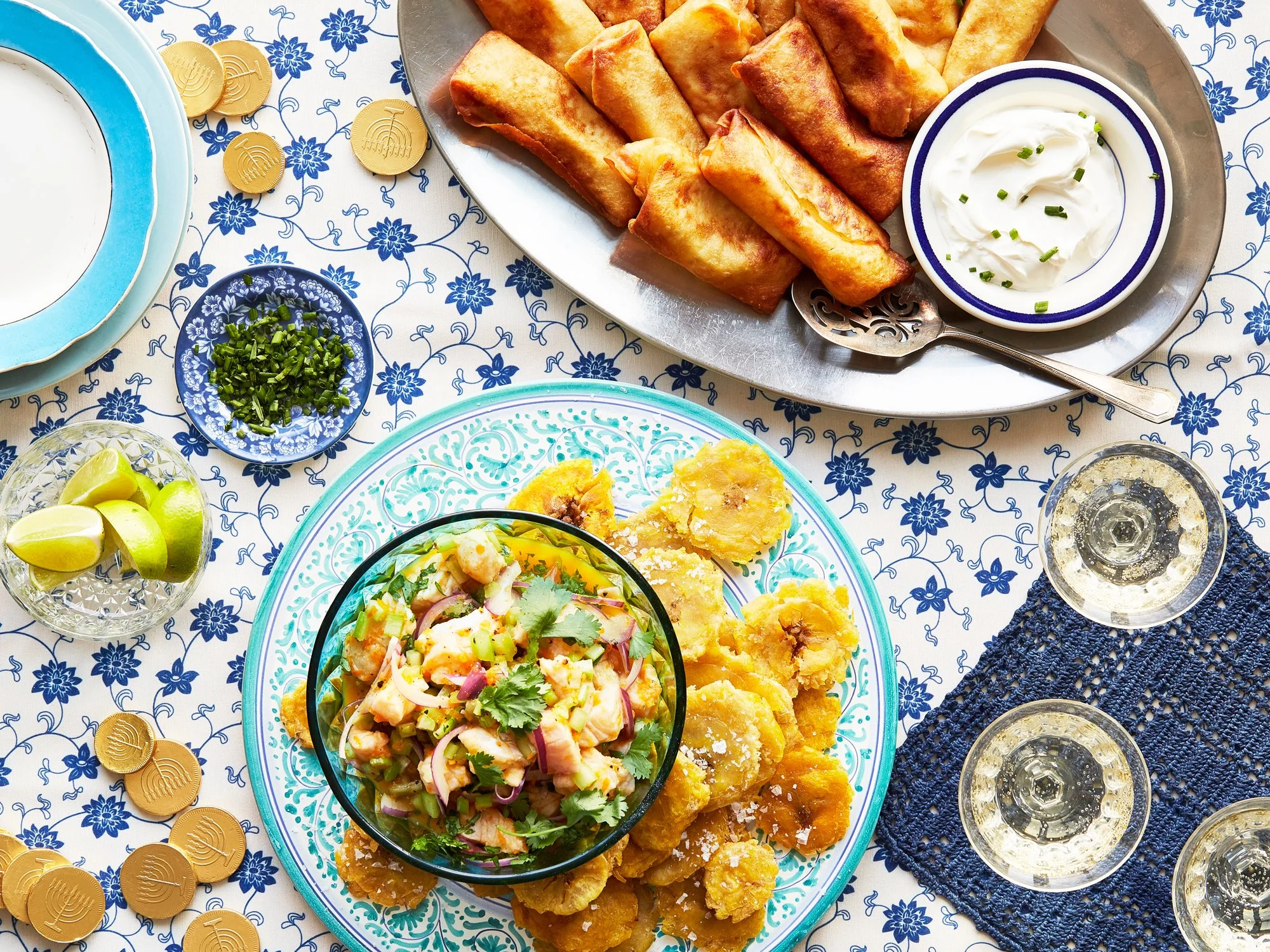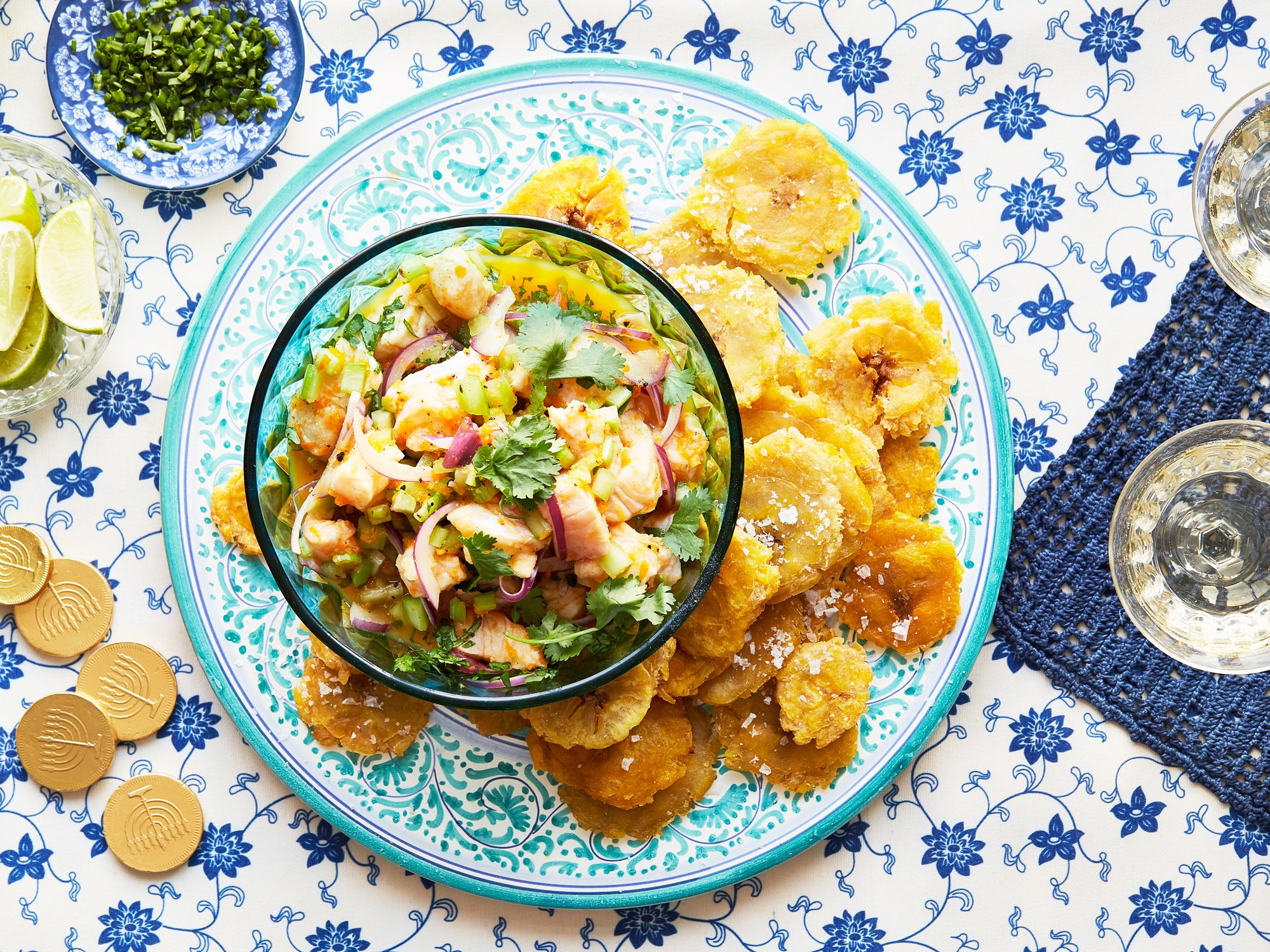Blintzes, Tostones, and Ceviche, This Family’s Hanukkah Spread Is a Map of Their History
Photos by Armando Rafael
Shared by Joel Linkewer
Recipe Roots: Baranavichy, Belarus > Santiago, Chile > San Juan, Puerto Rico > Miami
In Joel Linkewer’s family, meals are a map of where they’ve lived, tracing a route that’s 13,000 miles long from Belarus and Poland to South America, to Puerto Rico, and finally Miami.
When he was growing up, Hanukkah was celebrated with paper chains, cut outs in the shape of dreidels, and electric menorahs around his house in Miami. “Basically, the blue and white version of the Christmas decorations,” he says. His grandmother Ana Raquel and aunt Bettina would come over, often with dishes in tow, for a meal of Ashkenazi blintzes stuffed with pillowy potatoes, crisp and golden tostones or smashed and fried plantains from Puerto Rico, and on some years, a spicy and refreshing ceviche, which the family also learned to make on the Caribbean island. “This was our Hanukkah meal and it kind of changed and evolved with each place that we celebrated the holiday,” Joel explains.
In the 1930s, just before World War II, Joel’s great-grandparents left Eastern Europe. His grandmother’s family found their way to Santiago, Chile, while his grandfather’s relatives settled in Buenos Aires in Argentina. Despite living nearly 900 miles apart, the couple met at a wedding and later married, says Joel. After a few years in Argentina, they moved closer to Ana Raquel’s family in Chile living as part of the Santiago Jewish community. Here, she picked up recipes like spinach empanadas, a love of fish, and a passion for Hanukkah celebrations. “When my grandmother was growing up in Chile, it was a really big thing there,” says Joel. “She went to a Jewish school and they would put on a big festival for the community and she had always looked forward to it.”
In the early 1970s, when Joel’s father Jorge was little, the family moved again, this time to Puerto Rico, where his grandfather Abraham hoped to find work in Spanish. In San Juan, the family adopted ceviche and tostones into their tradition. And, after studying in the U.S. Joel’s father and much of the family settled in Miami. “That’s where the dots connected up,” says Joel. The recipes from all of their journeys came together on one table, made by his sister Lori, aunt, dad, grandmother, and his mother Jessica, who learned them from Ana Raquel.
At the Hanukkah celebrations, there’s always extra oil on hand after frying the tostones, so the family often fries latkes, and sometimes even falafel. It’s “horrible for the body, but good for the soul,” Joel says.
Ceviche
Serves: 6-8
Total Time: 35 minutes
This is a spicy dish, so you can reduce the amount of scotch bonnets based on your spice preference.
Ingredients
3 Scotch Bonnet Peppers, stems removed (orange color is best)
12 limes, juiced, divided (1 ½ cups)
3 tablespoons kosher salt
2 teaspoons ground black pepper
2 pounds Corvina or sea bass non-skin filets, cut into 1-inch cubes
4 celery stalks, finely diced
1 small red onion, thinly sliced
1 cup loosely packed cilantro, roughly chopped
Preparation
1. In a small food processor, pulse the Scotch Bonnet Peppers and the juice of 2 limes (¼ cup) for 30 seconds, until the peppers are well chopped.
2. In a medium bowl, add the remaining lime juice, the Scotch Bonnet Pepper mixture, salt, and pepper. Mix, cover it plastic wrap and chill for 1 hour in the refrigerator.
3. Remove from the refrigerator and add the fish. Mix well, and chill the mixture for an additional hour, mixing again halfway through.
4. Remove from the refrigerator and add the celery, onion, and cilantro. Mix well and serve immediately.
Tostones
Serves: 6 to 8
Total Time: 40 minutes
Ingredients
1 cup vegetable oil
4 green plantains, cut into 1-inch pieces crosswise
3 cups cold water
3 tablespoons kosher salt, divided
Preparation
1. Heat the oil in a large skillet over medium-low heat. Working in batches if needed, place the plantains in the oil and fry on both cut sides, approximately 4-5 minutes per side until golden and softened.
2. Remove the plantains from the pan and gently smash and flatten the pieces by pressing down with a plate. (If they do not flatten easily, return to the skillet until they are fully cooked through).
3. Fill a bowl with 3 cups of cold water and 1 ½ tablespoons of salt, stirring to dissolve. Briefly dip the flattened plantains in the water, then pat dry (this prevents discoloration in between frying and adds flavor).
4. Increase the heat of the skillet to high and once the oil is shimmering fry the plantain pieces 1 more time, for 1 minute on each side until crispy and golden brown. Transfer to a cooling rack or paper towel-lined plate and sprinkle with the remaining salt.
5. Serve with ceviche on the side.
Fried Blintzes
Time: 2 hours
Makes: 16 blintzes
Ingredients
For the filling:
2 tablespoons butter
2 large yellow onions, finely diced
4 russet potatoes, peeled and cut into ½-inch cubes
3 cloves of garlic, peeled and crushed
2 teaspoons kosher salt
½ teaspoon black pepper
For the crepes and assembly:
2 cups all purpose flour
2 cups whole milk
½ cup seltzer water
4 eggs
2 tablespoons butter, melted, divided, plus more as needed
Non-stick cooking spray
Vegetable oil, for frying
Sour cream and thinly sliced chives, for serving
Preparation
1. Prepare the filling: Add the potatoes and garlic to a large pot, cover with cold water, and add 2 teaspoons of salt. Cover and bring to a boil. Cook for 10 minutes, until the potatoes are easily cut with a fork. Drain and put through a potato ricer or pass through a fine sieve. Transfer to a large bowl.
2. While the potatoes cook, melt the butter over medium heat in an 8-inch nonstick skillet. Add the onions and 2 teaspoons of salt, and cook for 10 minutes until golden. Combine with the potatoes, add pepper, and adjust seasoning as needed. Set aside. Wipe out the skillet and set aside.
3. Make the crepes: In a large bowl, whisk the flour, milk, seltzer, eggs, and 2 tablespoons of melted butter until no lumps remain.
4. Spray the skillet with non-stick cooking spray or melt 1 tablespoon butter in the same 8-inch nonstick skillet over medium-low heat. Pour a ¼ cup of batter into the skillet and tilt to spread the batter in a very thin layer. Make sure to spread the batter evenly around the pan. Cook 2 minutes per side, until set. Transfer to a plate lined with parchment, and repeat with remaining batter. Set the skillet aside.
5. Assemble the blintzes: add ¼ cup of the filling in a line near the bottom edge of the crepe. Fold the lower edge up and over the filling. Then, fold each side in about 1-inch, and roll up, ending with the seam side facing down. Repeat with remaining filling and crepes.
6. Add ¼ cup of oil to the skillet and heat over medium. Working in batches, gently fry the blintzes for 1-2 minutes on each side, until they are lightly browned. Transfer to a cooling rack or paper towel-lined plate to drain excess oil. Serve warm, with sour cream and chives.
Cook’s note: You can make the crepes and filling 1 day ahead of time. Cover and refrigerate overnight, then fill and assemble the next day. This recipe can easily be doubled to serve a crowd.











